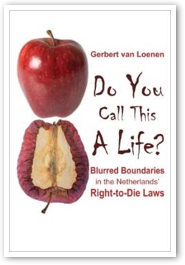The Real Dutch Disease
- BARBARA KAY
Euthanasia is so accepted that doctors must now justify prolonging a life.
 In 1994, Dutch journalist Gerbert van Loenen's partner Niek underwent surgery to remove what was thought to be a peasized brain tumour. More complicated than predicted, the operation resulted in a brain injury that left Niek permanently disabled, yet still able to enjoy quality of life.
In 1994, Dutch journalist Gerbert van Loenen's partner Niek underwent surgery to remove what was thought to be a peasized brain tumour. More complicated than predicted, the operation resulted in a brain injury that left Niek permanently disabled, yet still able to enjoy quality of life.
Van Loenen willingly reorganized his life to care for Niek at home. But after four years, his career needs necessitated moving Niek to a wheelchair-accessible unit across the street from a nursing home, where he was content for six more years until the tumour returned, whereupon he died a natural death.
Van Loenen found himself brooding over certain friends' reactions to their situation. "It would have been better if he had died," one said at the outset. Another told Niek when he expressed frustration, "You choose to go on living, so you have no right to complain." Once "an average Dutchman who thought of euthanasia as one of the crown jewels of our liberal country," van Loenen became "someone who was shocked by the harsh tone used by the Dutch when they talked about handicapped life."
He wondered if their attitudes could be traced back to the Dutch euthanasia law of 2002. The result of his curiosity is a forthcoming book, Do You Call This a Life? Blurred Boundaries in the Netherlands' Right-to-Die Laws. In it, the author traces the intellectual evolution behind the euthanasia law, the disparity between what people think the law permits and what it actually says, and the shift from self-determination — the principle from which arguments for assisted suicide and euthanasia always begin — to the "better-off-dead" judgmentalism van Loenen witnessed in his friends' responses to Niek.
The ideal candidate for activists' promotion of euthanasia or assisted suicide is a pain-tortured or disabled individual (or one about to become so) whose mind is crystal clear, and who demands the right to die on his own terms. Activists see these individuals as courageous, those who would refuse to help them as cowards, and their "right" to die as self-evident. Such activists often point to the Netherlands as their model for euthanasia progressivism.
But the Netherlands' euthanasia law does not recognize any such right. In 1984, the country's Supreme Court accepted euthanasia, but rejected self-determination as the driver. The law in fact focuses on the right of the physician to exercise his compassion in what is deemed a "situation of necessity." Citizens "may request," but cannot demand, euthanasia. So in fact the law endorses a species of medical "paternalism." Van Loenen claims this compassion-based perspective "is the opposite of self-determination," which he continues to support.
These doctors have acted outside the law, but are rarely convicted, as judges are reluctant to call "termination of life without request" ... murder.
One of van Loenen's settled convictions is that what begins in compassion invariably creeps over to the dark side. Up to 1,000 Dutch citizens are killed every year without express consent, according to van Loenen, either because they are incompetent (dementia) or in comas, or too young. In 14% of the without-consent cases, people are actually competent, but not consulted. Typical reasons given for euthanasia by doctors in such cases are "consultation would have done more harm than good," or "this course of action was clearly the best one for this patient," or it was "the request or wish of family" — a far cry from the self-determination principle debate began with.
These doctors have acted outside the law, but are rarely convicted, as judges are reluctant to call "termination of life without request" … murder. Indeed, van Loenen says, cultural acceptance of euthanasia has progressed to the point that it is no longer the physician who ends someone's life without request who must justify his actions; rather it is the physician who decides to prolong a life perceived as meaningless who feels societal pressure.
For me, the most unsettling aspect of this fascinating and informative book is the marginalization of the central actor — the "better-off-dead" person — as the discussion turns more and more to the sensibilities of those who are affronted by his continued existence.
In a disturbing illustration of this shift, van Loenen describes an award-winning 2006 Dutch documentary film about resuscitation, I Don't Ever Want to Be Famous, ostensibly featuring former cellist Tobias, disabled after a cardiac arrest and difficult post-resuscitation recovery. Van Loenen observes that Tobias seems content enough, and far less troubled by his straitened condition than some of his relatives, who candidly state they wish he had died.
At issue is whether Tobias should be resuscitated in a future incident. The family is shocked to discover that Tobias's anthroposophic care facility has a policy of resuscitation. The distraught mother complains, "Nobody told me … that there are so many taboos." His sister says, "I am sure this is not what he would have wanted. I am sure he would have said: euthanasia!" Whereupon Tobias says, very clearly, "I don't want to die." Nobody responds. This film is not really about him, or his wishes, or his rights.
To be continued in my column next week.
 This is J. Fraser Field, Founder of CERC. I hope you appreciated this piece. We curate these articles especially for believers like you.
This is J. Fraser Field, Founder of CERC. I hope you appreciated this piece. We curate these articles especially for believers like you.
Please show your appreciation by making a $3 donation. CERC is entirely reader supported.

Acknowledgement
 Barbara Kay "The Real Dutch Disease." National Post, (Canada) 28 Januuary, 2015.
Barbara Kay "The Real Dutch Disease." National Post, (Canada) 28 Januuary, 2015.
Reprinted with permission of the author, Barbara Kay, and the National Post.
The Author
 Barbara Kay is a Montreal-based writer. She has been a Comment page columnist (Wednesdays) in the National Post since September, 2003.
Barbara Kay is a Montreal-based writer. She has been a Comment page columnist (Wednesdays) in the National Post since September, 2003.


